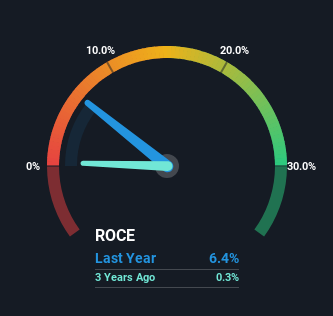- South Korea
- /
- Packaging
- /
- KOSDAQ:A037230
Returns On Capital At Hankukpackage (KOSDAQ:037230) Have Stalled
There are a few key trends to look for if we want to identify the next multi-bagger. Firstly, we'll want to see a proven return on capital employed (ROCE) that is increasing, and secondly, an expanding base of capital employed. This shows us that it's a compounding machine, able to continually reinvest its earnings back into the business and generate higher returns. However, after briefly looking over the numbers, we don't think Hankukpackage (KOSDAQ:037230) has the makings of a multi-bagger going forward, but let's have a look at why that may be.
Understanding Return On Capital Employed (ROCE)
If you haven't worked with ROCE before, it measures the 'return' (pre-tax profit) a company generates from capital employed in its business. To calculate this metric for Hankukpackage, this is the formula:
Return on Capital Employed = Earnings Before Interest and Tax (EBIT) ÷ (Total Assets - Current Liabilities)
0.064 = ₩7.9b ÷ (₩226b - ₩102b) (Based on the trailing twelve months to September 2024).
Thus, Hankukpackage has an ROCE of 6.4%. On its own, that's a low figure but it's around the 5.5% average generated by the Packaging industry.
See our latest analysis for Hankukpackage

Historical performance is a great place to start when researching a stock so above you can see the gauge for Hankukpackage's ROCE against it's prior returns. If you're interested in investigating Hankukpackage's past further, check out this free graph covering Hankukpackage's past earnings, revenue and cash flow.
What Can We Tell From Hankukpackage's ROCE Trend?
In terms of Hankukpackage's historical ROCE trend, it doesn't exactly demand attention. Over the past five years, ROCE has remained relatively flat at around 6.4% and the business has deployed 175% more capital into its operations. Given the company has increased the amount of capital employed, it appears the investments that have been made simply don't provide a high return on capital.
On another note, while the change in ROCE trend might not scream for attention, it's interesting that the current liabilities have actually gone up over the last five years. This is intriguing because if current liabilities hadn't increased to 45% of total assets, this reported ROCE would probably be less than6.4% because total capital employed would be higher.The 6.4% ROCE could be even lower if current liabilities weren't 45% of total assets, because the the formula would show a larger base of total capital employed. Additionally, this high level of current liabilities isn't ideal because it means the company's suppliers (or short-term creditors) are effectively funding a large portion of the business.
What We Can Learn From Hankukpackage's ROCE
In conclusion, Hankukpackage has been investing more capital into the business, but returns on that capital haven't increased. Unsurprisingly then, the total return to shareholders over the last five years has been flat. All in all, the inherent trends aren't typical of multi-baggers, so if that's what you're after, we think you might have more luck elsewhere.
One more thing: We've identified 3 warning signs with Hankukpackage (at least 2 which are significant) , and understanding these would certainly be useful.
While Hankukpackage may not currently earn the highest returns, we've compiled a list of companies that currently earn more than 25% return on equity. Check out this free list here.
Valuation is complex, but we're here to simplify it.
Discover if Hankukpackage might be undervalued or overvalued with our detailed analysis, featuring fair value estimates, potential risks, dividends, insider trades, and its financial condition.
Access Free AnalysisHave feedback on this article? Concerned about the content? Get in touch with us directly. Alternatively, email editorial-team (at) simplywallst.com.
This article by Simply Wall St is general in nature. We provide commentary based on historical data and analyst forecasts only using an unbiased methodology and our articles are not intended to be financial advice. It does not constitute a recommendation to buy or sell any stock, and does not take account of your objectives, or your financial situation. We aim to bring you long-term focused analysis driven by fundamental data. Note that our analysis may not factor in the latest price-sensitive company announcements or qualitative material. Simply Wall St has no position in any stocks mentioned.
About KOSDAQ:A037230
Hankukpackage
Hankukpackage Co., Ltd. manufacture and sell liquid packaging container in South Korea.
Solid track record and fair value.
Market Insights
Community Narratives




